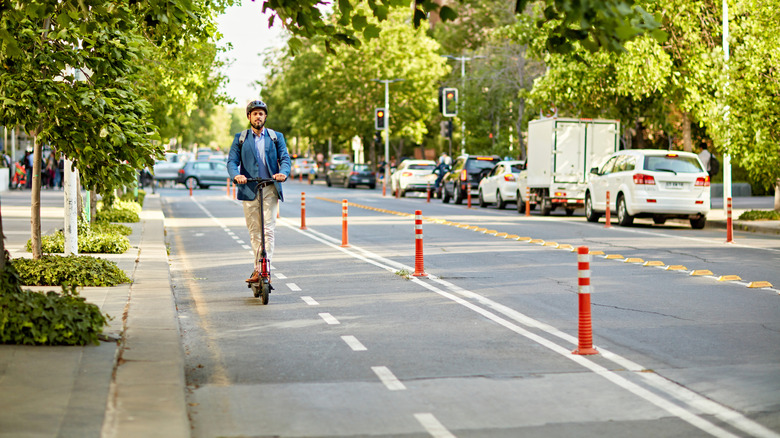Can You Ride An Electric Scooter In The Bike Lane? It's Complicated
Electric scooters and bikes are wildly popular today. Although you're more likely to see them in abundance in densely populated cities like New York, Chicago, Miami, and San Francisco, where congested streets are a significant problem, they can be found anywhere from suburbia to rural America.
With such a proliferation of cheap, compact means of transportation, the lines between these contraptions have blurred so quickly and dramatically that it's impossible to find a standard definition for an e-scooter. While it's easy to assume that your friendly neighborhood bike lanes have easy-to-follow rules, state laws regarding e-scooters and the use of bike lanes tend to be more contradictory than similar.
For example, neither Delaware nor Pennsylvania allows e-scooters on their roads at all. Delaware prohibits them outright on all public streets and sidewalks, and Pennsylvania hasn't even defined them under its current motor vehicle laws, so they're illegal everywhere. In eleven other states — California, Connecticut, Kansas, Montana, Nebraska, New York, North Dakota, Oklahoma, Tennessee, Vermont, and Washington — you can't ride e-scooters on sidewalks, but you can ride them on the road. Usually, this means you can ride in the bike lane if one's available.
Confusing the matter even more is that in many states, like California and Illinois, local city authorities can supersede any state ordinance, like in Libertyville, Illinois, which banned them outright. The bottom line is, you should forgo whatever the state law says and drill down to the precise local level where you're using the e-scooter to determine whether or not you can or can't ride your e-scooter in the bike lane.
Know the law so you don't get scatted on your scooter
Most states classify e-scooters as vehicles. California defines a "vehicle" as anything that moves a person, but it can't be human-powered. In this case, e-bikes and e-scooters are considered vehicles. The California DMV defines scooters as having "two wheels, a motor, handlebars, and a floorboard that you can stand on while riding it." They must be equipped with a brake, and they can't exceed 15 mph.
New York defines virtually anything "propelled by any power other than muscular power" as a motor vehicle, but excludes snowmobiles, ATVs, electric wheelchairs, e-bikes, and e-scooters. Since they aren't motor vehicles, they can go wherever bicycles can. Illinois considers e-scooters to be low-speed devices that weigh less than 100 pounds, have two or three wheels, but can't exceed 10 mph. In Florida, motorized electric scooters and bicycles are considered Micromobility Devices with three or fewer wheels, don't require a seat or saddle, but can't go faster than 20 mph. Florida law allows electric bicycles and scooters to use the bike lane, as they're considered bicycles.
In case it wasn't complicated enough, the speed limit of the road can sometimes dictate whether an e-scooter can use the bike lane. For instance, in Michigan, you can't ride an e-scooter on roads with a speed limit above 25 mph, but in Oklahoma, the limit is 35 mph. That's pretty fast for an e-scooter, and some types can travel faster than a Tesla. Ultimately, it's in your best interest to check your local DMV for the legal requirements in your area.

